MARIANI’S
Virtual Gourmet
April
3, 2016
NEWSLETTER
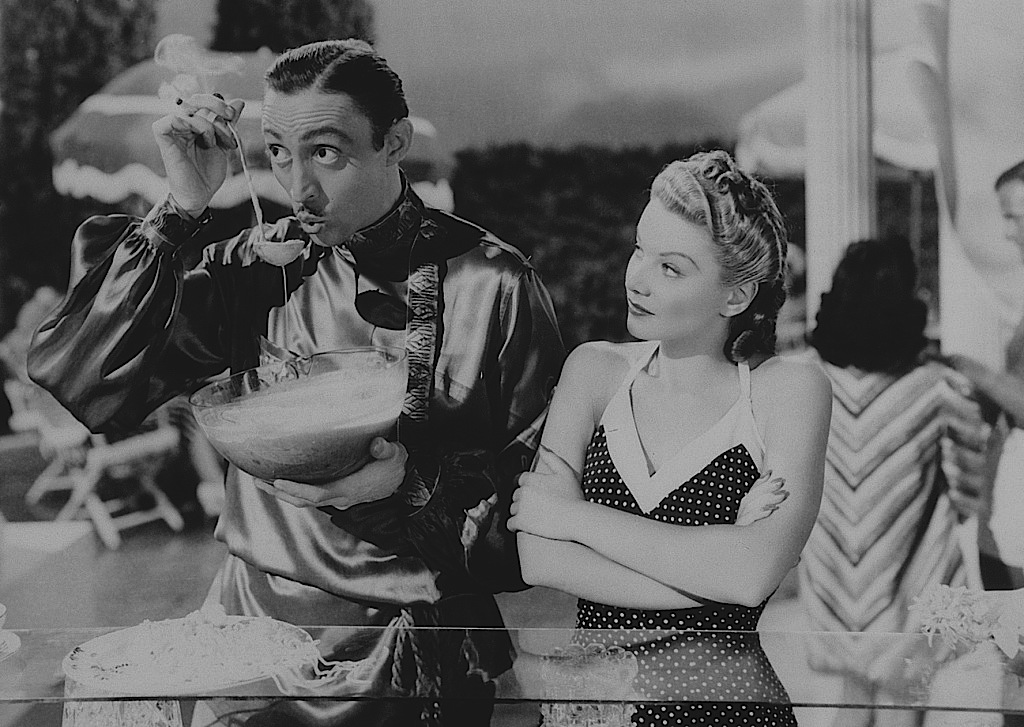
Misha
Auer and Barbara Brewster in "Flame of New Orleans"
(1941)
IN THIS ISSUE
LOUISVILLE, Part One
By John Mariani
THE TRUTH ABOUT HOW
TO EAT PIZZA
By John Mariani
NEW YORK CORNER
VAUCLUSE
By John Mariani
NOTES FROM THE WINE CELLAR
RED WINES FOR EARLY SPRINGTIME
By John Mariani
❖❖❖

AN ANNOUNCEMENT: On April 13 at 7 PM at the Westchester Italian Cultural Center in Tuckahoe, NY, John Mariani will give a convivial talk on "The Enduring Presence of Mamma in the Italian Kitchen." A light reception is offered prior to the beginning of the presentation from 6:30-7 PM. Members: $20, non-members $25. For details click here: www.wiccny.org
❖❖❖
LOUISVILLE,
Part One
By John Mariani

After decades of development
promises not kept and a lingering recession,
Louisville has lagged behind Southern cities like
Nashville, Greenville, and the Research Triangle
in creating enough excitement to bring in the big
tourist dollars.
But now the city seems poised for a boom
built on booze.
 The city’s movers
and boosters are betting the bank on Louisville’s
bourbon culture to drive tourism downtown, with
several distillers and visitors stores opening along
Main Street in the next two years. It’s a bet not
without ballast: According to the
Distilled Spirits Council, the combined U.S.
revenues for bourbon, Tennessee whiskey and rye
whiskey jumped 7.8 percent to $2.9 billion in 2015,
and domestic volume rose 5.2 percent to 20.4 million
cases, outpacing the overall distilled spirits
sector.
The city’s movers
and boosters are betting the bank on Louisville’s
bourbon culture to drive tourism downtown, with
several distillers and visitors stores opening along
Main Street in the next two years. It’s a bet not
without ballast: According to the
Distilled Spirits Council, the combined U.S.
revenues for bourbon, Tennessee whiskey and rye
whiskey jumped 7.8 percent to $2.9 billion in 2015,
and domestic volume rose 5.2 percent to 20.4 million
cases, outpacing the overall distilled spirits
sector.
One
third of the bourbon made now comes from Louisville.
A good deal of that will be poured into 100,000 bourbon-based Mint
Juleps during the Kentucky Derby and Kentucky Oaks
Derby next month. A lot more goes into the Old
Fashioned cocktail, said to have been perfected at
the city’s Pendennis Club.
The idea
for a new Whiskey Row (left) was preceded by a portion of
Main Street dubbed the “Wall Street of Whiskey,”
which once housed 50 bourbon-related businesses
before Prohibition.
An added appeal for bourbon-related tourism
is the Urban Bourbon Trail, a network of bars and restaurants
and stores in the city that promote the whiskey by
stocking at least 50 labels. It was established
in 2008, largely through the efforts of Stacey
Yates, VP of marketing communications for the Louisville Convention
& Visitors Bureau, who saw that
linking the restaurants like the Down One
Bar (right) and distilleries to
downtown’s nighttime activities would pull
everything together, and, in Yates’s words, “move
bourbon off the front porch.”
restaurants
and stores in the city that promote the whiskey by
stocking at least 50 labels. It was established
in 2008, largely through the efforts of Stacey
Yates, VP of marketing communications for the Louisville Convention
& Visitors Bureau, who saw that
linking the restaurants like the Down One
Bar (right) and distilleries to
downtown’s nighttime activities would pull
everything together, and, in Yates’s words, “move
bourbon off the front porch.”
The Trail began with eight stops; eight years
later, there are 34. (The state has had its own Kentucky Bourbon
Trail since 1999 that schedules
visits to nine distilleries outside of Louisville.)
Time will tell if so much focus
on bourbon will have a sustaining effect on tourism,
but the city has a lot more going for it culturally,
and, as seen over recent visits, the hotel and
restaurant scene is picking up steam the way it has
in other Southern cities like Nashville, Greenville,
and Raleigh. (I’ll report on dining out in
Louisville in my next article.)
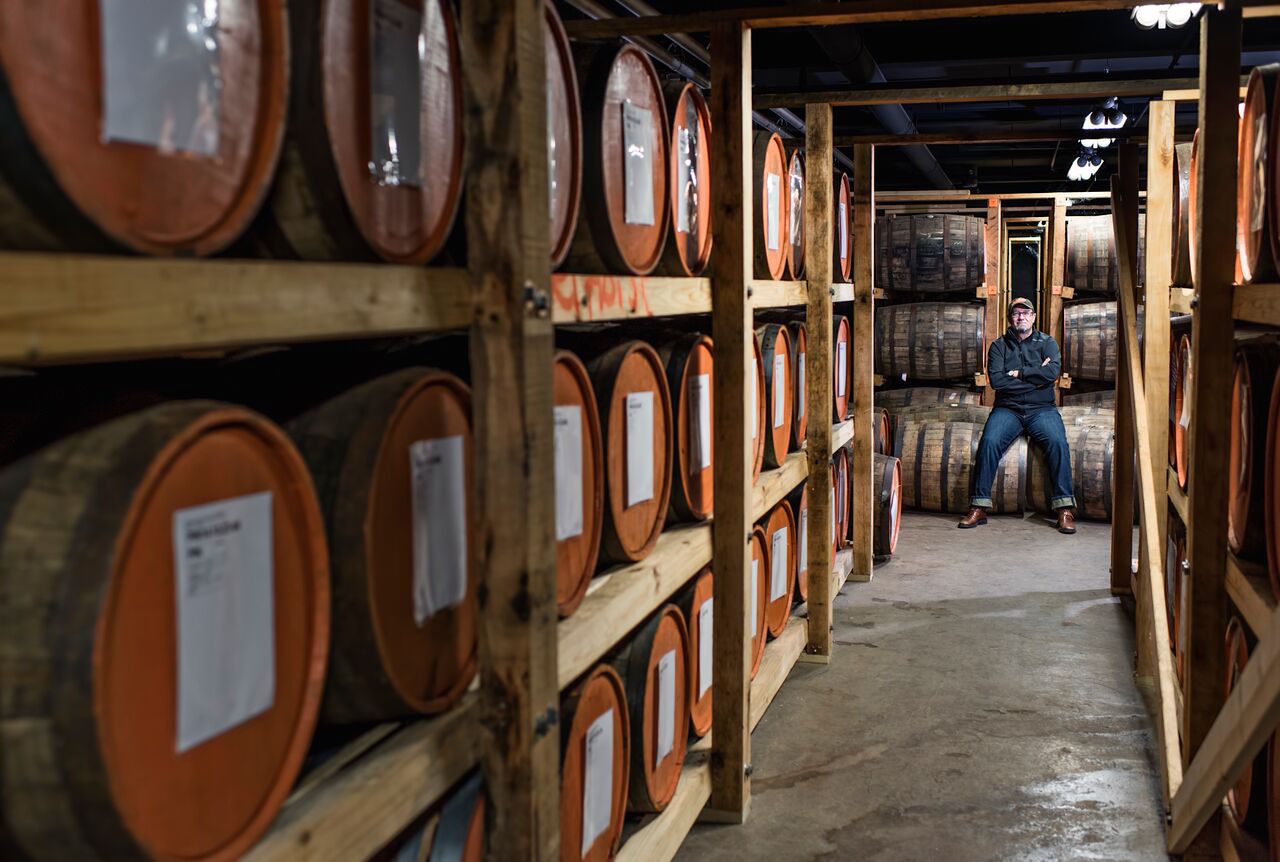
One of the current and most
dynamic of the city's craft distilleries is Copper & Kings
(right)
in the Butchertown neighborhood, which makes "definitive American Brandy
influenced by American Whiskey and American music.
We do not make
derivative brandy styled upon a European
sensibility. We use a low & slow
distillation philosophy, by which a relatively low
distillation temperature makes for a longer,
slower distillation and maximum copper still contact
to express concentrated flavors, aromas, and
smoothness." The distillations are made from
brandy varietals-- French Colombard, Muscat de
Alexandria and Chenin Blanc sourced largely in the
Central Valley and Central Coast regions of
California.
For those interested in history and architecture, the Old Louisville neighborhood has the largest collection of Victorian homes in the U.S. As a well-situated and prosperous river town during the Civil War, and having sided with the North, Louisville, though threatened, was
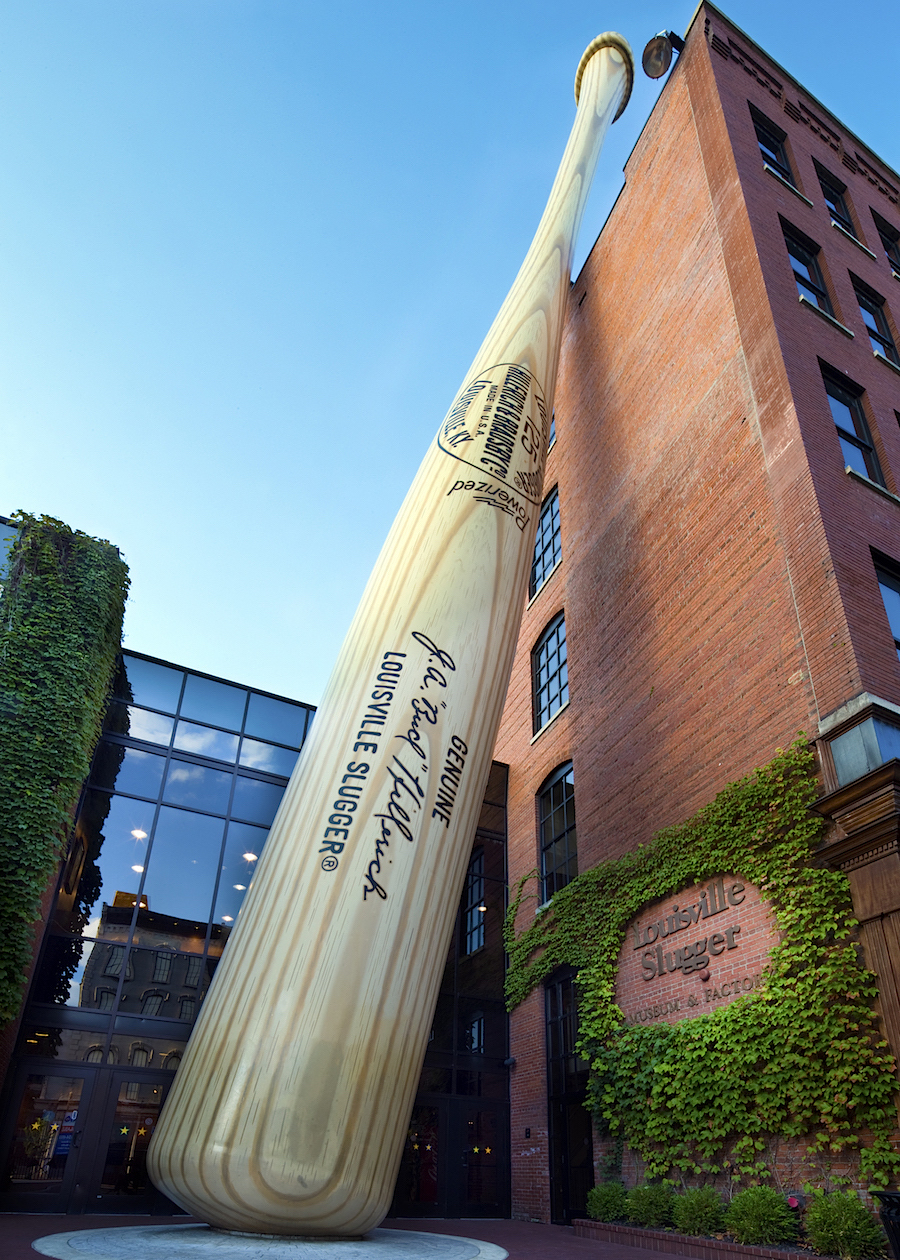 never attacked and
survived pretty much intact.
never attacked and
survived pretty much intact.Downtown is home to the 12-year-old Frazier History Museum, with an outstanding collection of armaments. There is also the Kentucky Science Center, while The Kentucky Museum of Art and Craft is devoted to arts, crafts and design. Closed in 2013 for a total rebuilding, the Speed Art Museum, adjacent to the University of Louisville, is scheduled to re-open this year, with more than 12,000 pieces of art in its permanent collection. Outside the Louisville Slugger Museum and Factory there is a 120-foot replica of Babe Ruth's 34-inch Louisville Slugger bat (right), a huge piece of Pop Art that weighs 68,000 pounds.
Already one of the most popular visitor attractions is The Muhammad Ali Center devoted to Louisville’s native son. And in the neighborhood dubbed “NuLu,” east of downtown, you’ll find a slew of new galleries, antique stores and restaurants within the historic district. The Kentucky Center features plays and concerts throughout the year, and hosts Louisville Ballet, Bourbon Baroque, Stage One Family Theatre, the Kentucky Opera, and the Kentucky Shakespeare Festival, the country’s oldest. The Louisville Orchestra (founded in 1937) operates out of the magnificent Palace Theater.
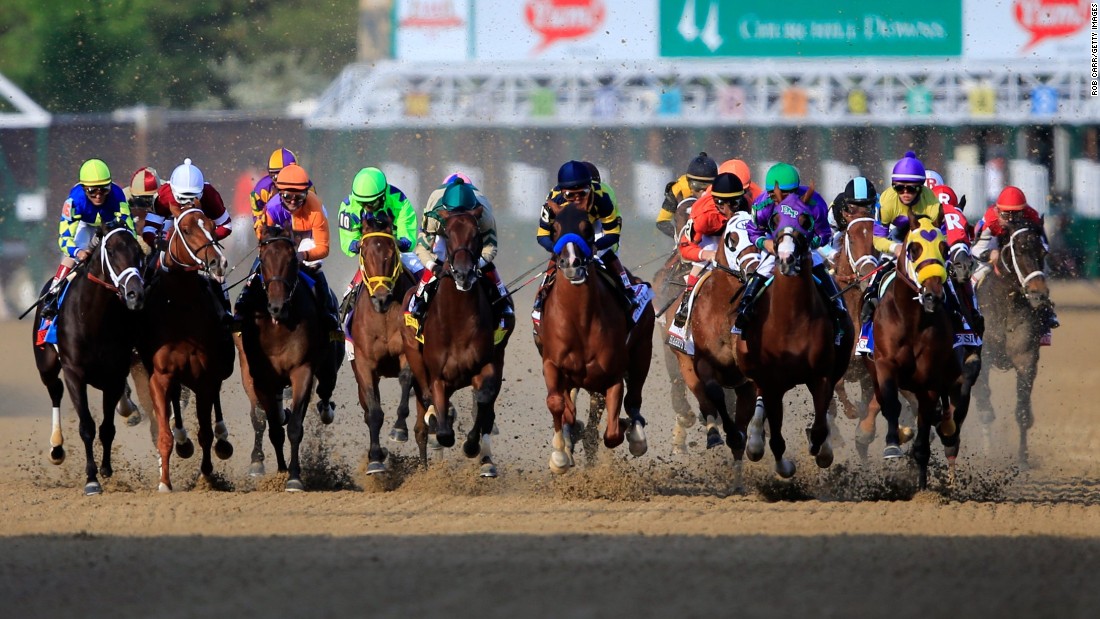 All
around town there are other performing arts
theaters, from the Savage Rose Classical Theatre and
The Bard's Town Theatre
Company, to the Louisville Repertory Theatre,
Louisville Improvisors, and Squallis Puppeteers.
In another couple of
weeks, of course, Louisville will be packed when the
Kentucky Derby is held at Churchill Downs. Every stratum of
Kentucky society as well as American visitors and
foreign tourists attend this uniquely colorful
weekend of horse racing, parties in historic houses
and tailgate picnics.
The mint juleps are shaken cold and served in
their traditional frosted silver mugs, and the city
shows its brightest and most glamorous face, when
everyone joins in singing the state anthem “My Old
Kentucky Home.”
All
around town there are other performing arts
theaters, from the Savage Rose Classical Theatre and
The Bard's Town Theatre
Company, to the Louisville Repertory Theatre,
Louisville Improvisors, and Squallis Puppeteers.
In another couple of
weeks, of course, Louisville will be packed when the
Kentucky Derby is held at Churchill Downs. Every stratum of
Kentucky society as well as American visitors and
foreign tourists attend this uniquely colorful
weekend of horse racing, parties in historic houses
and tailgate picnics.
The mint juleps are shaken cold and served in
their traditional frosted silver mugs, and the city
shows its brightest and most glamorous face, when
everyone joins in singing the state anthem “My Old
Kentucky Home.”
THE TRUTH ABOUT HOW
TO EAT PIZZA
By John Mariani
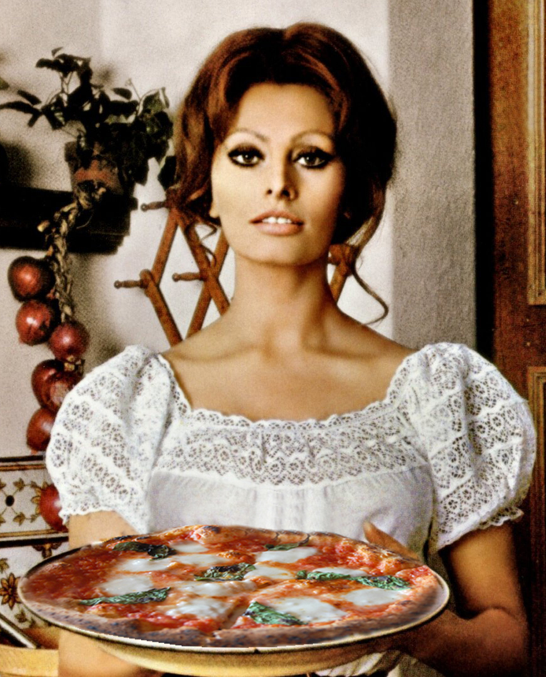
The
ever-vigilant American food media are always poised
to find a prominent person, preferably a politician,
caught eating pizza “the wrong way!” 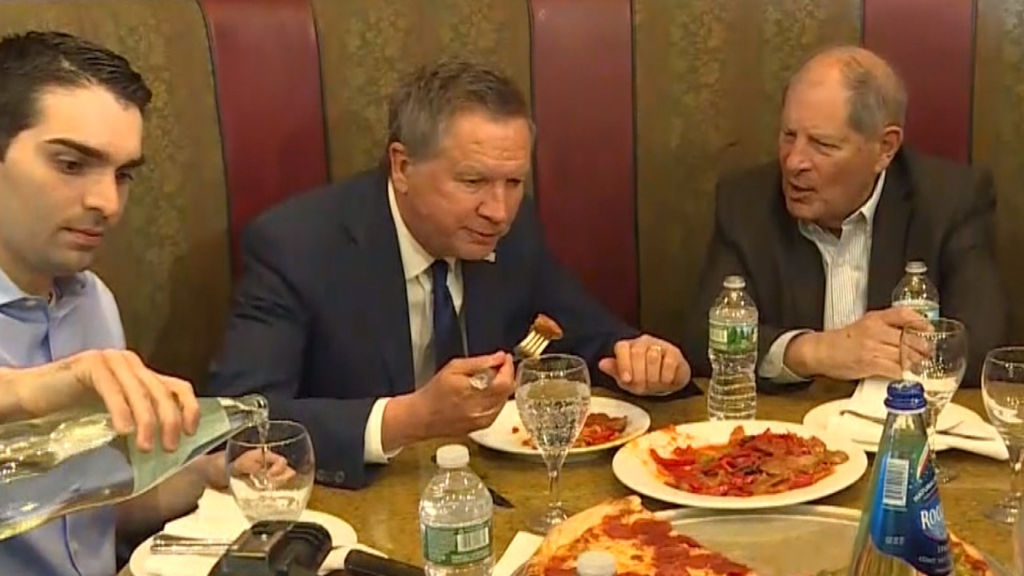 Latest is Republican presidential
candidate John Kasich (left), excoriated in the press for
using a knife and fork on a slice of pizza at Gino’s
Pizzeria in Howard Beach in Queens, NY, causing him
to explain on Good Morning
America: “Look, look, the pizza
came scalding hot, okay? And so I used a little
fork. You know what? My wife, who is on spring break
with my daughters, said, `I'm proud of you. You
finally learned how to use a utensil properly.”
Latest is Republican presidential
candidate John Kasich (left), excoriated in the press for
using a knife and fork on a slice of pizza at Gino’s
Pizzeria in Howard Beach in Queens, NY, causing him
to explain on Good Morning
America: “Look, look, the pizza
came scalding hot, okay? And so I used a little
fork. You know what? My wife, who is on spring break
with my daughters, said, `I'm proud of you. You
finally learned how to use a utensil properly.”
To
which New York magazine’s hipster Grub
Street columnist sniffed, “Oh, right,
because the pizza was hot. Pizza is supposed
to be hot. A slice of New York pizza should land in
front of you radiating heat to an almost terrifying
degree, blasted in an oven that burns with the fury
of a thousand hellfires. You are supposed to know
that if you eat it too quickly you will incinerate
the roof of your mouth so thoroughly that it will
tingle and feel kinda weird and numb for the rest of
the afternoon.”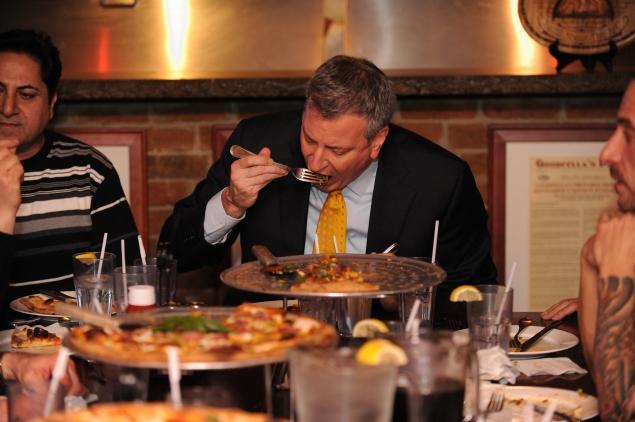
Even New York's Italian-American Mayor
Bill de Blasio was eviscerated for being seen using
a knife and fork on his pizza -- once on Staten
Island just after he took office, and another time
in Italy while on vacation (right).
O.K., here’s the low-down: Pizza, which was created
in Naples in the 17th century as a streetside snack
food served by the slice, was nicknamed a “libretto,”
little book, because it was bought, folded and eaten
with the fingers. But as pizzas became more of
an item ordered as an individual whole pie at
pizzerias and trattorias, albeit smaller than
American pizzas, it was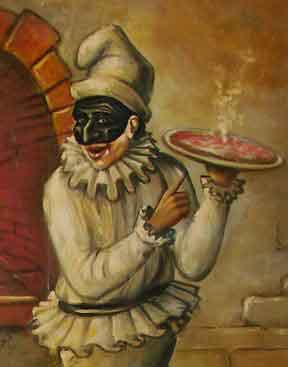 eaten with a
fork and knife. Indeed, if you are anywhere in
Italy eating inside, rather than grabbing a slice on
the go, you will immediately be identified as an
American if you fold up a slice and chomp on
it.
eaten with a
fork and knife. Indeed, if you are anywhere in
Italy eating inside, rather than grabbing a slice on
the go, you will immediately be identified as an
American if you fold up a slice and chomp on
it.
So, while the way of
pizza-eating in America may well be to fold and eat,
it is not
the Italian way, so de Blasio, in Italy, was doing
as the Romans do, while Kasich was making his wife
proud.
Let’s lighten up, eh?
Now, what's this about
Trump eating his steak well done?
❖❖❖
By John Mariani
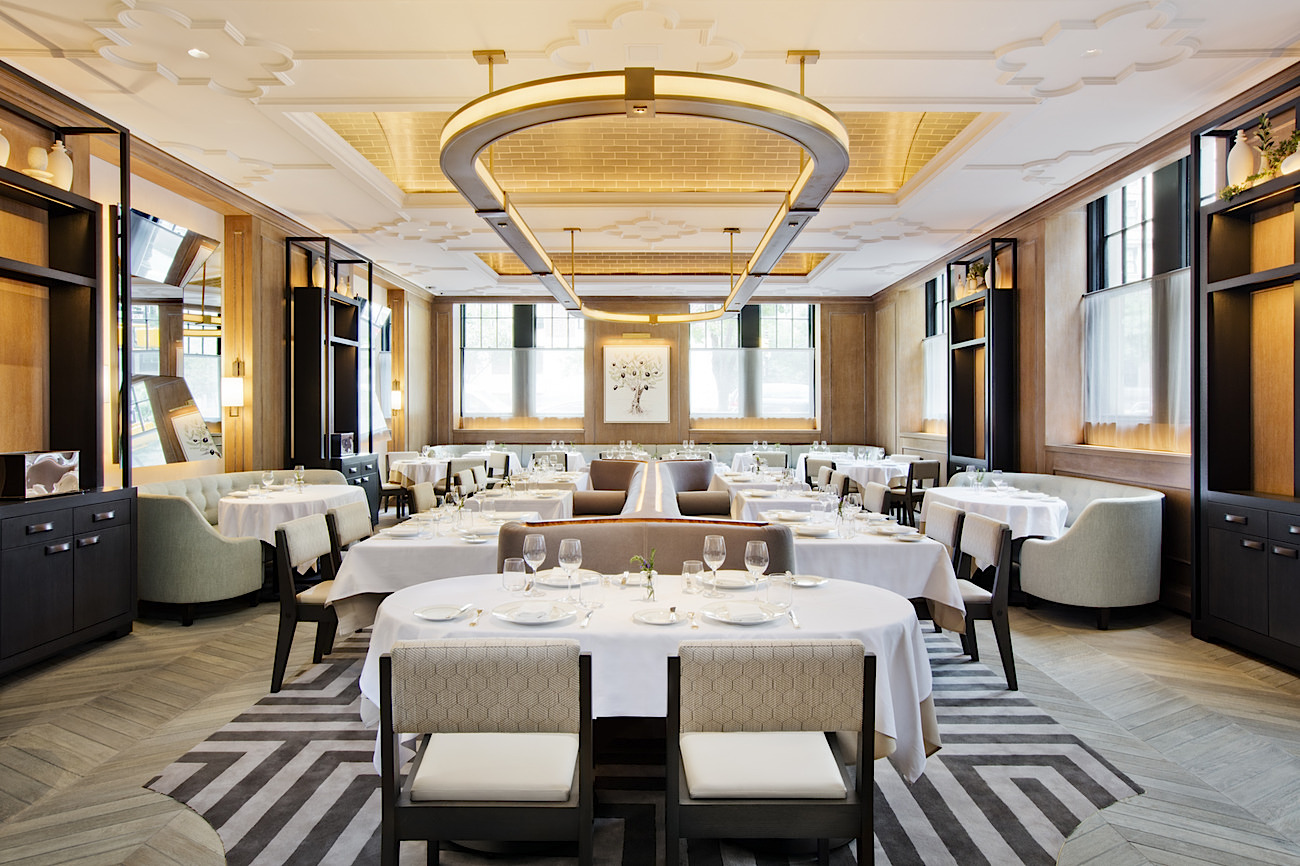
VAUCLUSE
100 East 63rd Street (off Park Avenue)
646-869-2300
vauclusenyc.com
There were some raised
eyebrows among the NYC food media when Michael
White and his Altamarea Group opened a French
restaurant named Vaucluse last summer—after
launching fourteen Italian restaurants over the
past few years, including Marea, which did for
Italian seafood what Le Bernardin had done for
French. I
have not dined at every one of Altamarea’s
restaurants, which now stretch from New Jersey
to Las Vegas, Washington DC, Hong Kong,
Istanbul, and London, but those I have dined at
in NYC have, for the most part, been stellar
additions, despite a couple of flops along the
way.
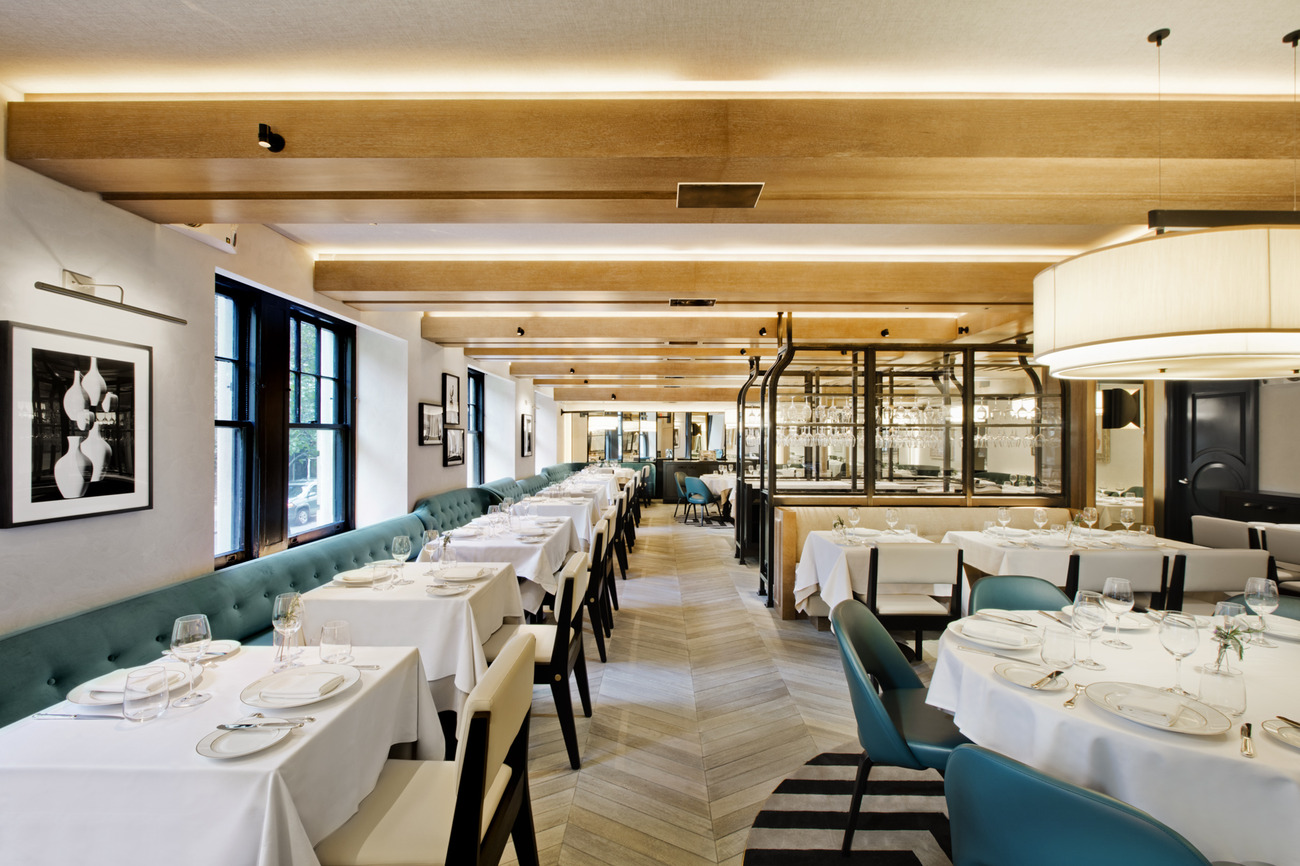 It is certainly a legitimate
question how White can properly oversee so many
ventures on three continents, in the same way that
entrepreneur chefs like Alain Ducasse, Gordon
Ramsay, Charlie Palmer, Jean-Georges Vongerichten
and so many others do these days. There
is obviously a point at which the excellence of
White’s original restaurants, where he was always
on premises cooking, cannot be sustained with an
absentee chef-leader, as if a conductor rarely
sets food on the podium.
It is certainly a legitimate
question how White can properly oversee so many
ventures on three continents, in the same way that
entrepreneur chefs like Alain Ducasse, Gordon
Ramsay, Charlie Palmer, Jean-Georges Vongerichten
and so many others do these days. There
is obviously a point at which the excellence of
White’s original restaurants, where he was always
on premises cooking, cannot be sustained with an
absentee chef-leader, as if a conductor rarely
sets food on the podium.
Still, Vaucluse, on the Upper
East Side premises of what had been Park Avenue
Café, is very much a departure for White in that
it is a straight-down-the-line French restaurant
akin to some of those contemporary dining rooms of
Paris like Benôit (owned by Ducasse), Atelier
Maître Albert and Les Bookinistes (Guy Savoy),
Lazare (Eric Fréchon) and Le
Quinzième (Cyril Lignac). In each
of these you’ll find a good deal of traditional
and classic cooking always given a personal twist
that redeems them from being predictable. Little
on Vaucluse’s menu can be exalted as wholly
innovative, but almost every dish I tried showed
the heightened attention of a kitchen not content
to provide basic bistro/brasserie fare.
The renovations to the bi-level
dining rooms make Vaucluse as refined as any you’d
find in NYC or Paris right now. Downstairs
is a loud buzz;
upstairs, which has been referred to in the
press as “Siberia” (above), is actually a far more
congenial and civilized room for conversation. That I
had no choice was due to a hostess who, noting I
was the first in my party to arrive, sniffed, “You
can wait at the bar.” Not “Would you care to
wait at the bar?” I replied that I’d rather go to
my table, causing her to turn to the sub-hostess
and snap, “Thirty-three,” without so much as an
“Enjoy your dinner.” Nevertheless I preferred the
quieter room of Siberia to the boisterous, if “preferred,”
downstairs dining room.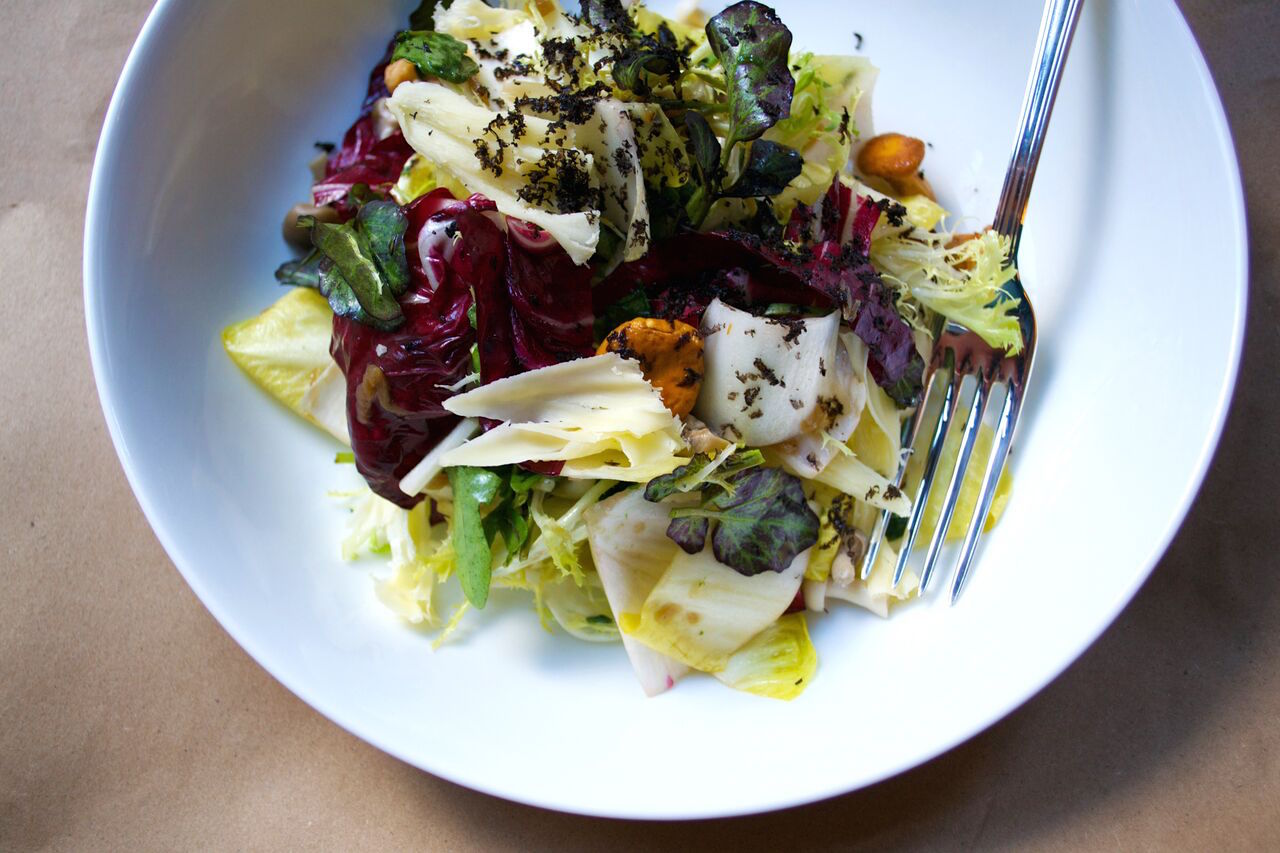
The wine list, overseen by
sommelier Leigh Weissman, is as admirably
comprehensive as at other Altamarea restaurants
but far more focused, as it should be, on French
selections.
Curiously, prices by the bottle are quite
fair, the markup often less than 100%, but by the
glass you get gouged for wines like a $20
Christian Moreau Chablis 2014 that sells for $25
in the wine shop.
Cocktails run $17.
The spring menu is now in
effect, so aside from a selection of oysters with
red wine mignonette (six for $21) and American
caviar (a whopping $115 per ounce), there is a
pretty salad with mesclun, mushrooms à la grecque
and shavings of tête de moine
cheese and black truffles ($22)—a salad it would
be difficult not to love (right). Tartare of beef with
capers, cornichons and toasted baguette ($21) was
good, if not earth-shaking. A silky terrine of
foie gras took on the added interest of guinea
hen, with shaved asparagus and a dash of sweet
Sauternes, served with sourdough bread ($26).
When I saw onion consommé on
the menu ($19) I hesitated, knowing that 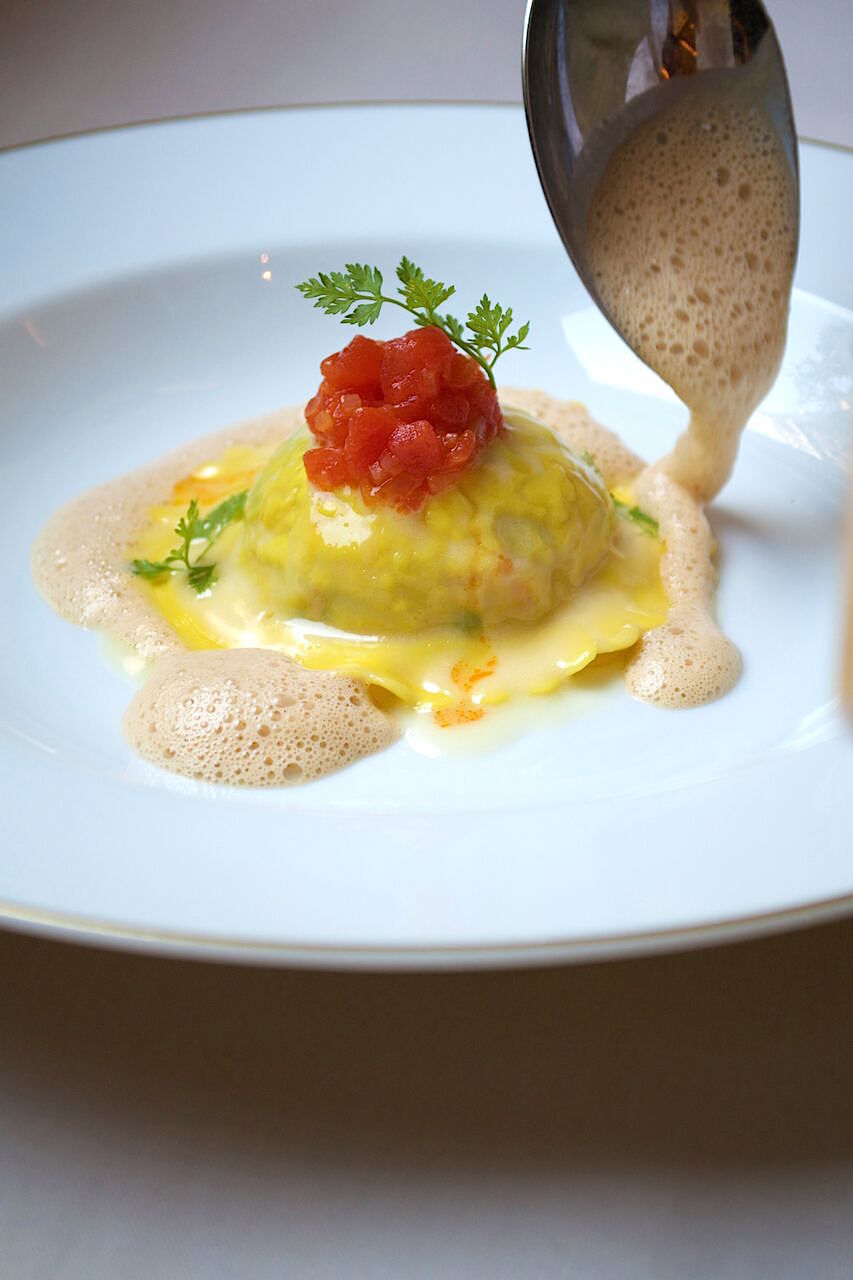 this deceptively simple reduction
was once a staple of menus everywhere but one now
rarely seen.
The late restaurateur Joe Baum used to
barrel through his kitchen and complain about the
consommé without even tasting it, growling to his
cooks, “I don’t have to. There’s always something
wrong
about the consommé.” So I decided to see if White
and his cooks could bring this classic soup back
to eminence and was giddy upon finding they did.
For not only was the broth deeply flavorful and of
a perfect dark copper color, but the unexpected
addition of bone marrow and a little tartine topped
with
melted Gruyère added measurably to the sweetness
of the slowly reduced onions.
this deceptively simple reduction
was once a staple of menus everywhere but one now
rarely seen.
The late restaurateur Joe Baum used to
barrel through his kitchen and complain about the
consommé without even tasting it, growling to his
cooks, “I don’t have to. There’s always something
wrong
about the consommé.” So I decided to see if White
and his cooks could bring this classic soup back
to eminence and was giddy upon finding they did.
For not only was the broth deeply flavorful and of
a perfect dark copper color, but the unexpected
addition of bone marrow and a little tartine topped
with
melted Gruyère added measurably to the sweetness
of the slowly reduced onions.
Since everyone expects White to
have pasta on his menus, and because there is
hardly a French restaurant anywhere that does not
these days, he’s added four. The lobster raviolo
with fines
herbes and a rich shellfish bisque (left) was
very good, very creamy and did actually taste of
lobster, but $26 for one large raviolo
as a starter tilts towards exorbitance.
Each day there is a specialty,
such as boeuf
bourguignnone on Wednesday and blanquette de
veau on Thursday. Under “Viandes”
you’ll find a beautifully cooked filet of veal
done à la
Rossini, with fresh sautéed foie gras, a
caramelized onion tartine and a deliciously extracted
black truffle jus ($46,
which is actually a fairly moderate price). Next to
the consommé, I found the slow-cooked rabbit leg
with barley and bacon superb, just kissed with
enough Dijon mustard to bring up all the flavors
($35), and it was a surprisingly big leg for a
rabbit. I
did not have a chance to try the duck à l’orange
(another French item you don’t see much any more)
because it is only served for two ($42 per
person).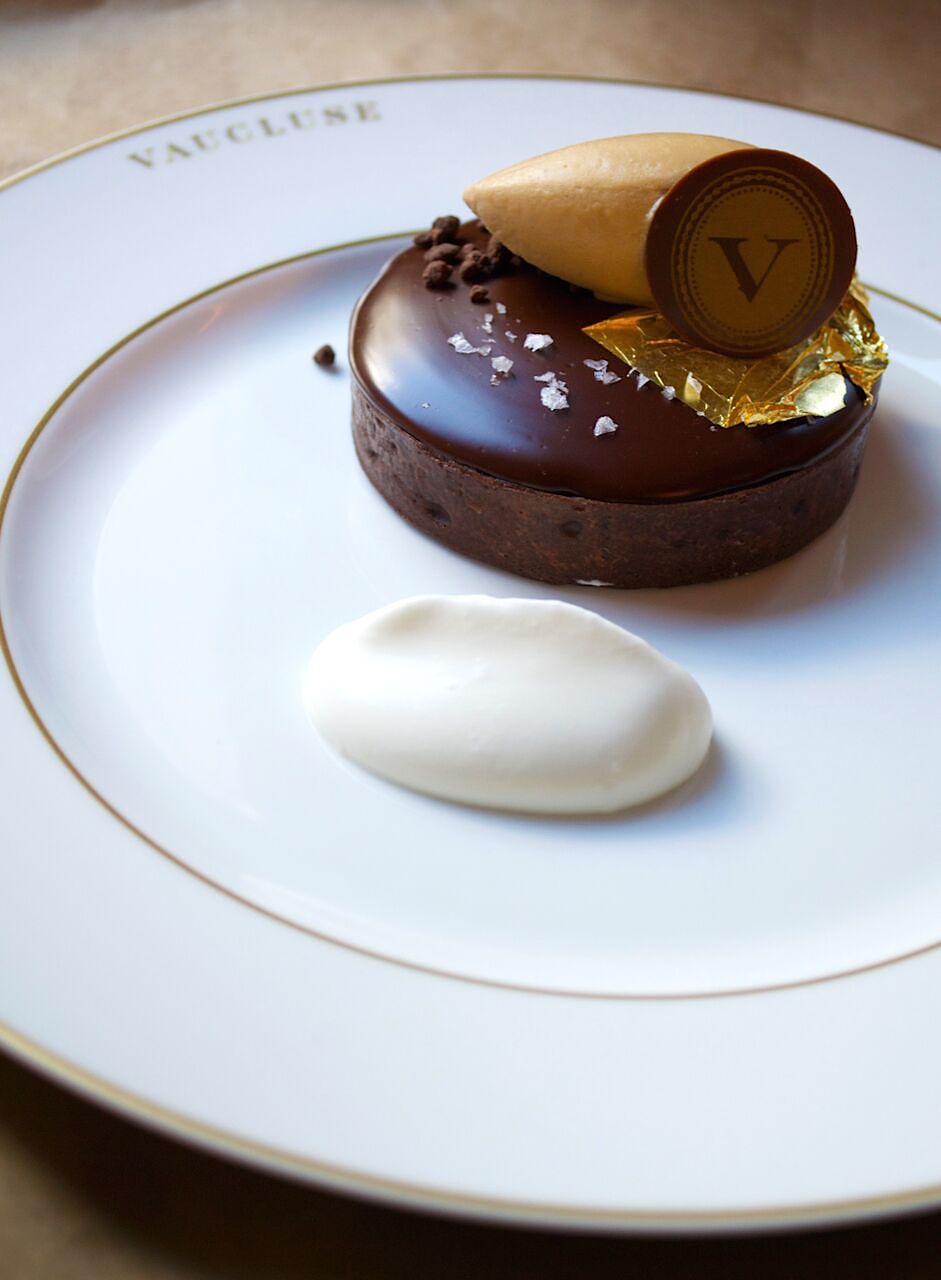
There is a cheese selection of
six French varieties ($17 for three, $23 for five)
and an excellent list of dessert wines to go with
them by the glass.
Alina
Martell, formerly at White’s deluxe Italian place
Ai Fiori, is now going full-tilt French with very
fine renderings of chocolate cake (right) with
mocha crèmeux,
genoise and caramel glaze ($15), and a tangy
lemon tart with Meyer lemon cream, brown sugar breton
cookie, and citron glaze ($13). I’m
always a sucker for Paris-Brest (named after a
1910 bicycle race), that
way-too-much-of-a-good-thing made with a ring of pâte à choux
pastry filled with caramelized white chocolate and
a praline croquant
($13), though the crust was not as crisp as it
should be and the interior cream tasted more like
whipped Chantilly cream.
I for one am happy White has
tried his hand at a French restaurant—after all,
he had extensive training in France as well as in
Italy—one that does not try to compete with the
more nouvelle
examples at Jean-Georges. Instead,
for its sophistication and modernity of design,
Vaucluse rises above the evergreen charms of
bistros that perform by rote, and in its cuisine
there is far more personal expression and
attention to detail than you might have expected. Then
again, why would you not from someone of White’s
stature? Now,
if he’d only alight more at his restaurants, all
would be even better.
Open
for Lunch Mon.-Fri.; Dinner nightly; Brunch Sun.
❖❖❖
WINES FOR EARLY SPRINGTIME
By John Mariani

Joseph Drouhin Domaine des Hospices
de Belleville Fleurie 2014 ($26) and Morgon 2014
($21.50)—Properly aged Beaujolais are starting to
blunt the inane reputation of Beaujolais Nouveau,
and these two examples from Joseph Drouhin show
all the color, fruit and time-will-tell ripeness
that is achieved after slow fermentation and six
months of aging before bottling. The Morgon is
lovely for springtime dishes like baby lamb, while
the somewhat fleshier Fleurie, from the most
southern terroir of Beaujolais, takes well to
dishes like roast pork with prunes.
Nobilo Icon Marlborough Pinot Noir
2014 ($19)—New Zealand Pinot Noirs can be
lighter than Australian examples among New World
wines, and
can give a better bang for the buck. In this
case you get a solid, well-knit NZ-PN with plenty
of cherry flavors of a kind the grape should
deliver without the inky sweetness, and the 13.5%
alcohol is just where it should be.
Matanzas Creek Winery Jackson Park
Vineyard Merlot 2012 ($60)—While its price pushes the upper
limits for American merlot, Matanzas Creek has
been delivering excellent examples for three
decades from the cooler Bennett Valley in Sonoma.
Winemaker Marcia Monahan-Torres uses a clone from
the illustrious Château Pétrus of Bordeaux and it
shows this silky red wine.
 Vistalba
Corte A 2012 ($70)—The continuing evolution of
impressive red wines from Mendoza, Argentina, is
on full display with this massive, 15.5% alcohol
blend of 67% Malbec,
25% Cabernet Sauvignon and 8% Bonarda from a
vineyard dating back to 1948. Founder Carlos
Pulenta wants his wines to age, and I think this
will indeed be better when it is softer and more
balanced. Right
now the first sip raises eyebrows for its fruit
and density, but, were I on a hacienda in Mendoza
with a side of beef on a spit, I’d drink this now.
But better to wait.
Vistalba
Corte A 2012 ($70)—The continuing evolution of
impressive red wines from Mendoza, Argentina, is
on full display with this massive, 15.5% alcohol
blend of 67% Malbec,
25% Cabernet Sauvignon and 8% Bonarda from a
vineyard dating back to 1948. Founder Carlos
Pulenta wants his wines to age, and I think this
will indeed be better when it is softer and more
balanced. Right
now the first sip raises eyebrows for its fruit
and density, but, were I on a hacienda in Mendoza
with a side of beef on a spit, I’d drink this now.
But better to wait.
I
Veroni Chianti Rufina Riserva 2011
($$25-$30)—Twenty-First century Chiantis differ so
radically from what the wines once were that it’s
impossible to say any are typical of the name. Yet,
while Chianti Classicos get most of the attention,
there are excellent Chiantis from other Tuscan
regions, including this D.O.C.G. Rufina, made from
100% Sangiovese (once the wine would have also
contained Canaiolo Nero, Colorino, even
Trebbiano).
This is a big, bold, meaty red with a hefty
fruit component softened by 18 months in French
oak and 10 months in bottle.
Tenute
Cisa
Asinari dei Marcheso di Gresy Langhe Martinenga
Nebbiolo 2014
($22)—The Nebbiolo (below) grape goes into
Piedmont’s great Barolos and Barbarescos, but it
is also a workhorse for wines of Langhe, and this
example’s 13.5% alcohol shows a level of
refinement you might not expect for $22. The
Martinenga vineyard actually lies within the
environs of Barbaresco, so you’re getting much the
same terroir and a much lower price. Excellent
with tomato sauces and ones made with funghi
porcini.
goes into
Piedmont’s great Barolos and Barbarescos, but it
is also a workhorse for wines of Langhe, and this
example’s 13.5% alcohol shows a level of
refinement you might not expect for $22. The
Martinenga vineyard actually lies within the
environs of Barbaresco, so you’re getting much the
same terroir and a much lower price. Excellent
with tomato sauces and ones made with funghi
porcini.

Montesodi del Castello di Nipozzano Frescobaldi
2011
($27-$35)—The aristocratic Frescobaldi family has
700 years of experience making Tuscan wines, and
its Montesodi label shows just how impeccably a
modern I.G.T. wine can be made, which is “only in
exceptional years” from Sangiovese. With bistecca alla
fiorentina, this wine is perfect, easy to
drink, yet formidable at every point on the
palate.
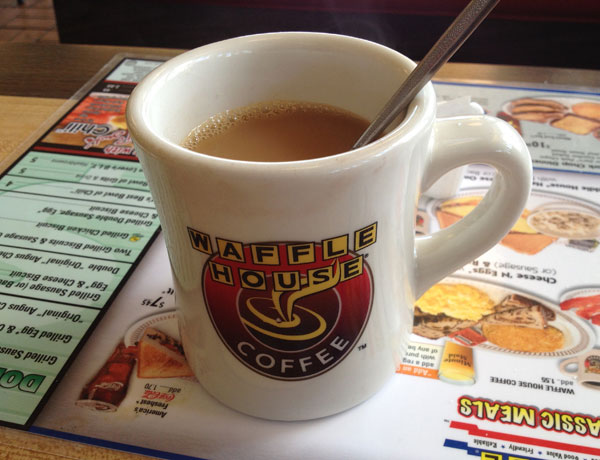 FRESHEN THAT FER YA'?
FRESHEN THAT FER YA'?A Waffle House waitress
named Sonserea Dawn Evans was fired and arrested
after she allegedly (on video tape) put
methamphetamine in her co-worker's
drink, leaving him comatose for four weeks and
unable to walk afterwards.
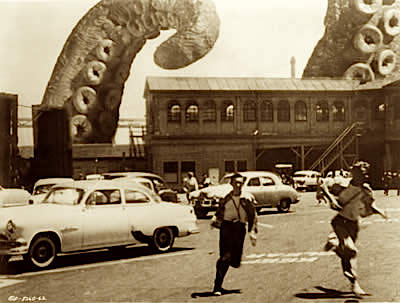
“Damn it, he had me at
churros. Yeasty, Flintstone-esque femurs of barely
sweetened fried dough arriving searing hot from the
fryer, and dusting of cinnamon sugar making sexy-eyes at
a ramekin of chocolate sauce. . . . His fattoush purrs
vibrancy, tangling humble pita bread croutons with
scallions, yellow peppers, and cucumbers along with
snaps of lemon juice and Za’ata. But it’s his
octopus dish that stops traffic.”—“Where to Eat Now,” Cincinnati Magazine
(April 2016).
Any of John Mariani's books below may be ordered from amazon.com.
 I'm proud and happy to announce that my
new book, The Hound
in Heaven (21st Century Lion Books), has just
been published through Amazon and Kindle.
I'm proud and happy to announce that my
new book, The Hound
in Heaven (21st Century Lion Books), has just
been published through Amazon and Kindle. It is a novella, and for anyone who loves dogs, Christmas, romance, inspiration, even the supernatural, I hope you'll find this to be a treasured favorite. The story concerns how, after a New England teacher, his wife and their two daughters adopt a stray puppy found in their barn in northern Maine, their lives seem full of promise. But when tragedy strikes, their wonderful dog Lazarus and the spirit of Christmas are the only things that may bring back his master back from the edge of despair.
WATCH THE VIDEO!
“What a huge surprise turn this story took! I was completely stunned! I truly enjoyed this book and its message.” – Actress Ali MacGraw
“He had me at Page One. The amount of heart, human insight, soul searching, and deft literary strength that John Mariani pours into this airtight novella is vertigo-inducing. Perhaps ‘wow’ would be the best comment.” – James Dalessandro, author of Bohemian Heart and 1906.
“John Mariani’s Hound in Heaven starts with a well-painted portrayal of an American family, along with the requisite dog. A surprise event flips the action of the novel and captures us for a voyage leading to a hopeful and heart-warming message. A page turning, one sitting read, it’s the perfect antidote for the winter and promotion of holiday celebration.” – Ann Pearlman, author of The Christmas Cookie Club and A Gift for my Sister.
“John Mariani’s concise, achingly beautiful novella pulls a literary rabbit out of a hat – a mash-up of the cosmic and the intimate, the tragic and the heart-warming – a Christmas tale for all ages, and all faiths. Read it to your children, read it to yourself… but read it. Early and often. Highly recommended.” – Jay Bonansinga, New York Times bestselling author of Pinkerton’s War, The Sinking of The Eastland, and The Walking Dead: The Road To Woodbury.
“Amazing things happen when you open your heart to an animal. The Hound in Heaven delivers a powerful story of healing that is forged in the spiritual relationship between a man and his best friend. The book brings a message of hope that can enrich our images of family, love, and loss.” – Dr. Barbara Royal, author of The Royal Treatment.
 |
The Encyclopedia of American Food and Drink by John F. Mariani (Bloomsbury USA, $35) Modesty forbids me to praise my own new book, but let me proudly say that it is an extensive revision of the 4th edition that appeared more than a decade ago, before locavores, molecular cuisine, modernist cuisine, the Food Network and so much more, now included. Word origins have been completely updated, as have per capita consumption and production stats. Most important, for the first time since publication in the 1980s, the book includes more than 100 biographies of Americans who have changed the way we cook, eat and drink -- from Fannie Farmer and Julia Child to Robert Mondavi and Thomas Keller. "This book is amazing! It has entries for everything from `abalone' to `zwieback,' plus more than 500 recipes for classic American dishes and drinks."--Devra First, The Boston Globe. "Much needed in any kitchen library."--Bon Appetit. |
"Eating Italian will never be the same after reading John Mariani's entertaining and savory gastronomical history of the cuisine of Italy and how it won over appetites worldwide. . . . This book is such a tasteful narrative that it will literally make you hungry for Italian food and arouse your appetite for gastronomical history."--Don Oldenburg, USA Today. "Italian
restaurants--some good, some glitzy--far
outnumber their French rivals. Many of
these establishments are zestfully described
in How Italian Food Conquered the World, an
entertaining and fact-filled chronicle by
food-and-wine correspondent John F.
Mariani."--Aram Bakshian Jr., Wall Street
Journal.
"Equal parts
history, sociology, gastronomy, and just
plain fun, How Italian Food Conquered the
World tells the captivating and delicious
story of the (let's face it) everybody's
favorite cuisine with clarity, verve and
more than one surprise."--Colman Andrews,
editorial director of The Daily
Meal.com. "A fantastic and fascinating
read, covering everything from the influence
of Venice's spice trade to the impact of
Italian immigrants in America and the
evolution of alta cucina. This book will
serve as a terrific resource to anyone
interested in the real story of Italian
food."--Mary Ann Esposito, host of PBS-TV's
Ciao
Italia. "John Mariani has written the
definitive history of how Italians won their
way into our hearts, minds, and
stomachs. It's a story of pleasure over
pomp and taste over technique."--Danny Meyer,
owner of NYC restaurants Union Square
Cafe, The Modern, and Maialino.
|
 |
 |
 |
 |
 |
 |
 |
 |
 Everett Potter's Travel Report:
Everett Potter's Travel Report: 
 Eating Las
Vegas JOHN CURTAS has been covering
the Las Vegas food and restaurant scene
since 1995. He is the co-author of EATING LAS
VEGAS – The 50 Essential Restaurants (the
fourth edition of which will be published in
early 2016), as well as the author of the Eating Las
Vegas web site: www.eatinglasvegas.
He can also be seen every Friday morning as
the “resident foodie” for Wake Up With the
Wagners on KSNV TV (NBC) Channel 3 in
Las Vegas.
Eating Las
Vegas JOHN CURTAS has been covering
the Las Vegas food and restaurant scene
since 1995. He is the co-author of EATING LAS
VEGAS – The 50 Essential Restaurants (the
fourth edition of which will be published in
early 2016), as well as the author of the Eating Las
Vegas web site: www.eatinglasvegas.
He can also be seen every Friday morning as
the “resident foodie” for Wake Up With the
Wagners on KSNV TV (NBC) Channel 3 in
Las Vegas.

MARIANI'S VIRTUAL GOURMET
NEWSLETTER is published weekly. Editor/Publisher: John
Mariani.
Editor: Walter Bagley. Contributing Writers: Christopher Mariani,
Robert Mariani, Misha
Mariani,
John A. Curtas, Edward Brivio, Mort Hochstein,
Andrew Chalk, Dotty Griffith and Brian Freedman. Contributing
Photographers: Galina Dargery, Bobby
Pirillo. Technical Advisor: Gerry McLoughlin.
To un-subscribe from this newsletter,click here.
© copyright John Mariani 2016

